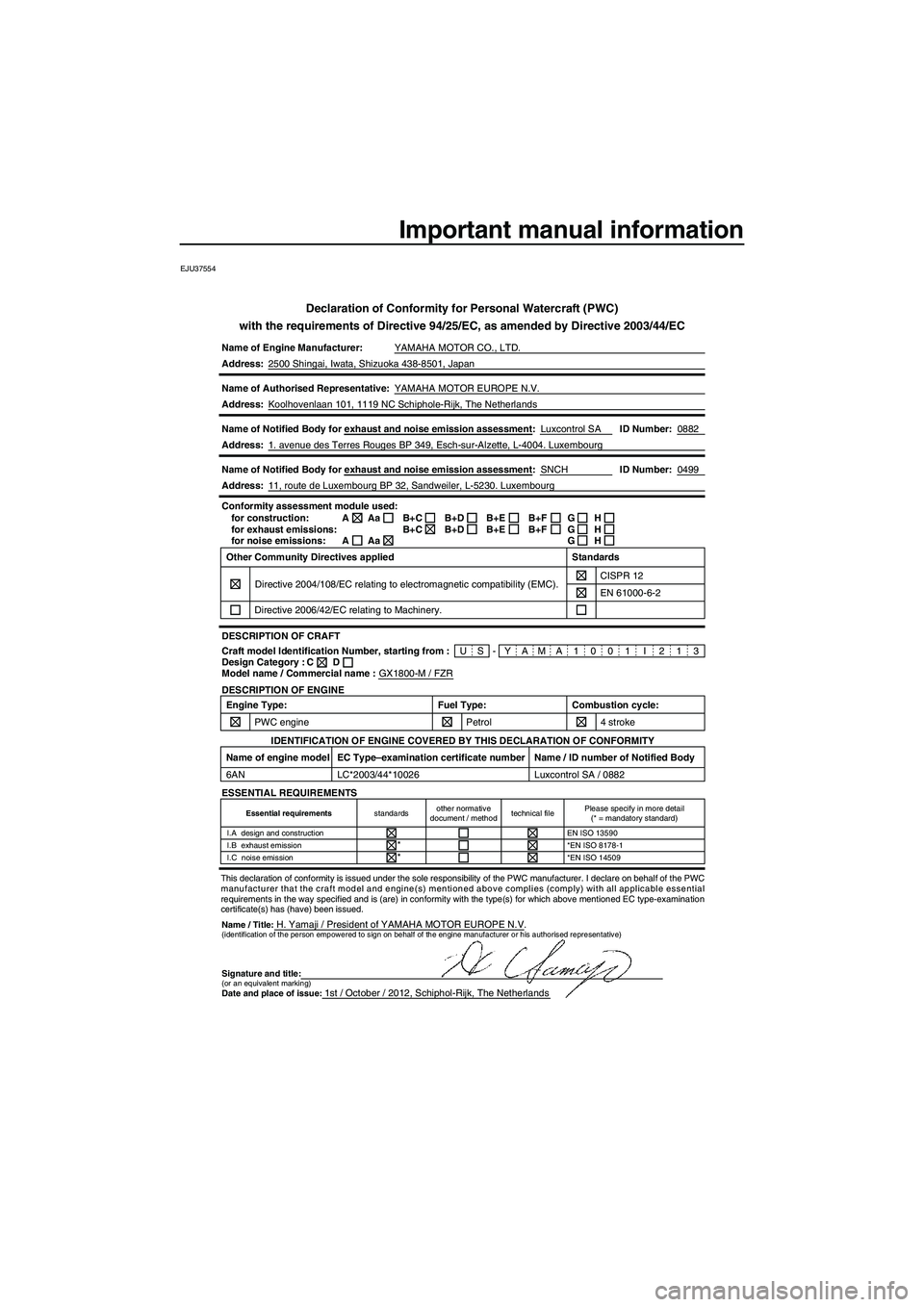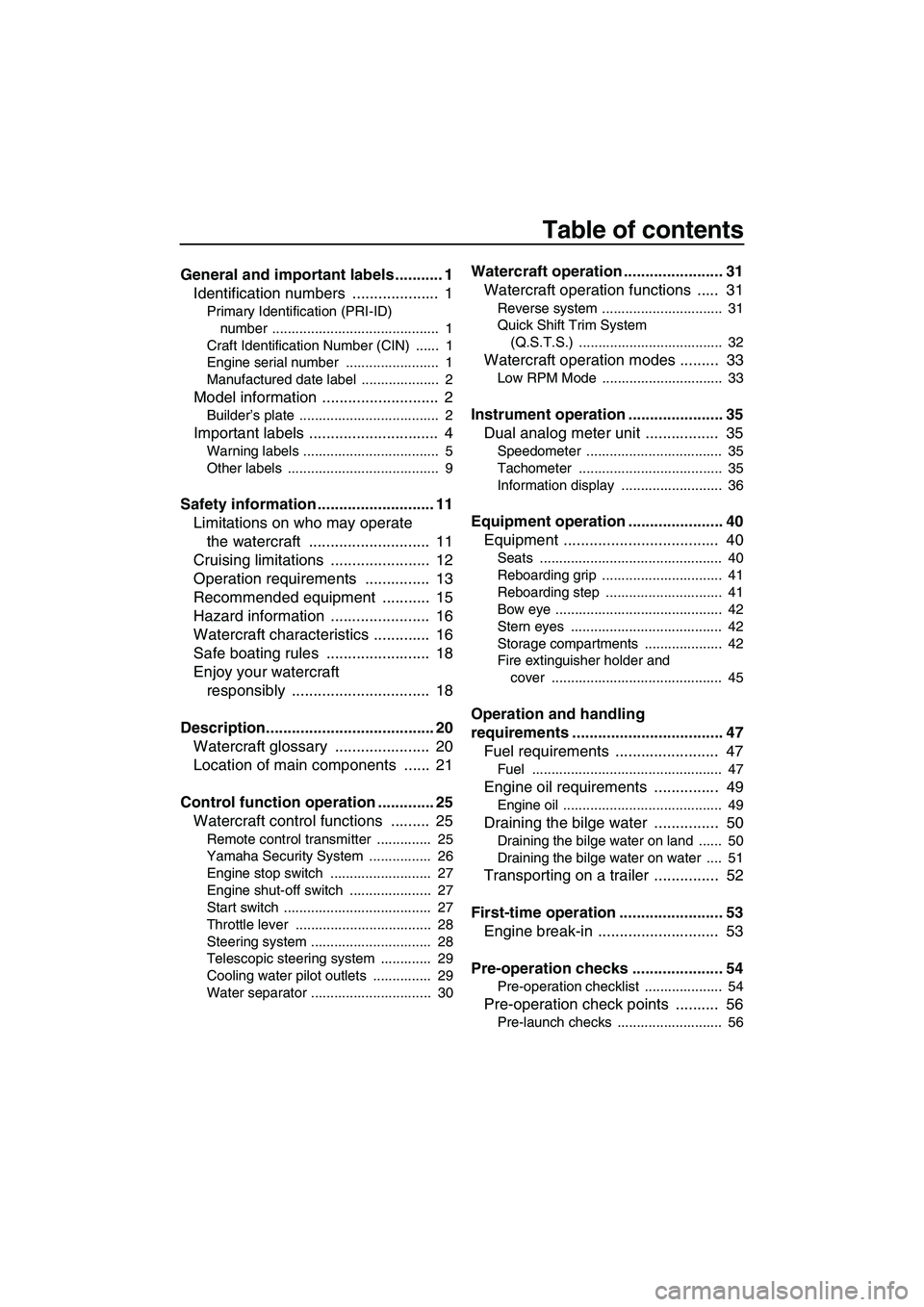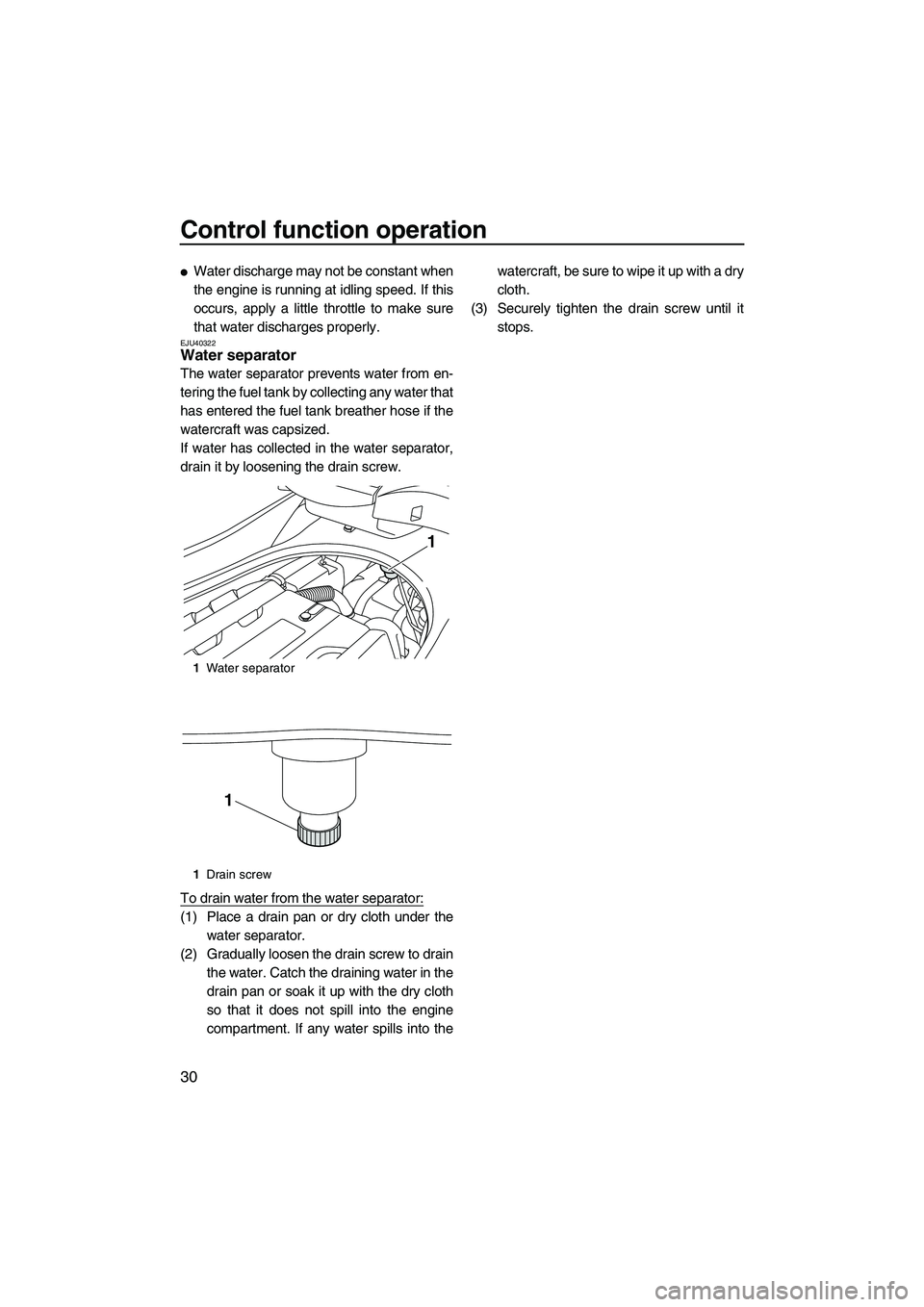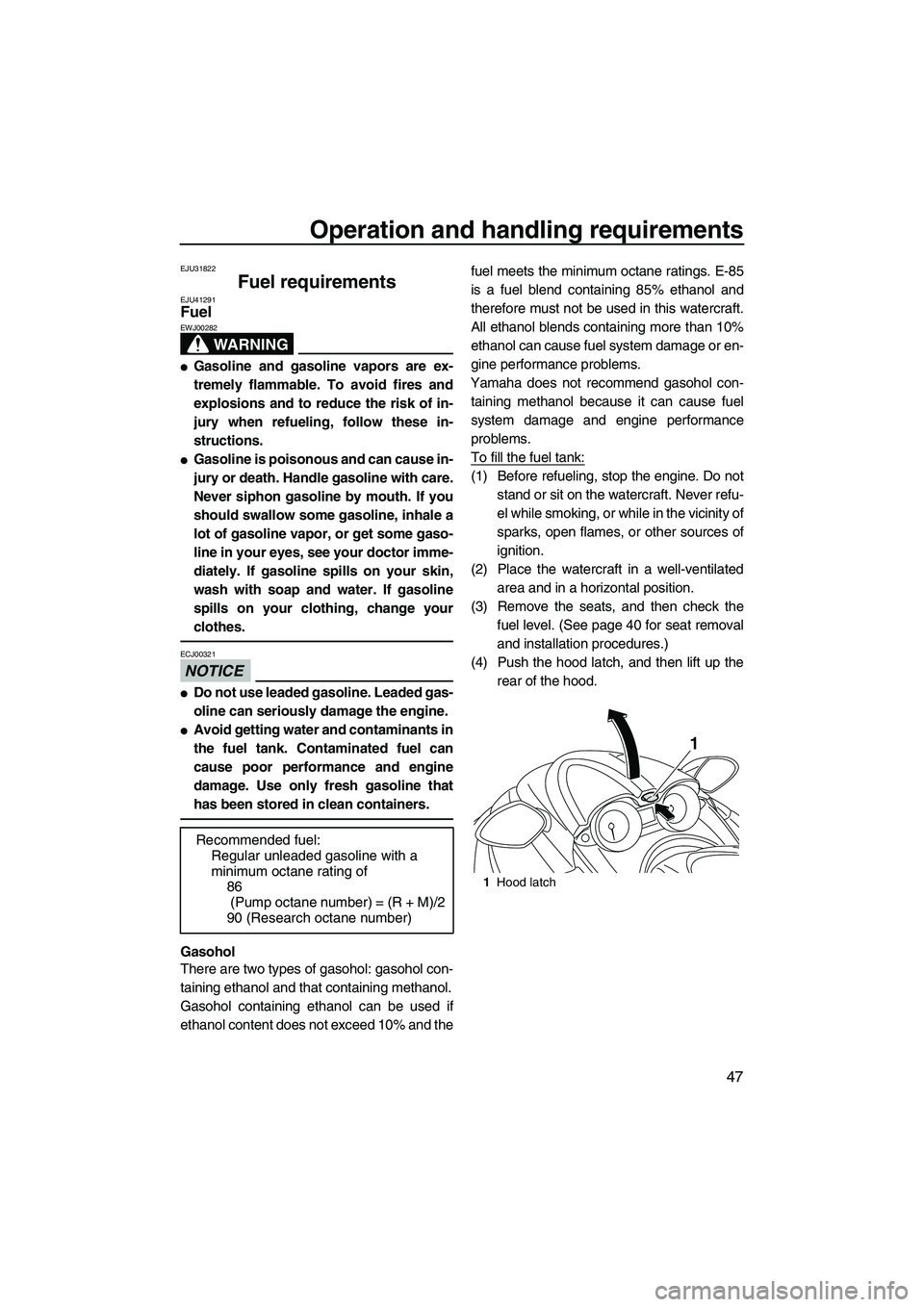fuel YAMAHA FZR 2013 Owners Manual
[x] Cancel search | Manufacturer: YAMAHA, Model Year: 2013, Model line: FZR, Model: YAMAHA FZR 2013Pages: 104, PDF Size: 5.07 MB
Page 3 of 104

Important manual information
EJU37554
Declaration of Conformity for Personal Watercraft (PWC)
with the requirements of Directive 94/25/EC, as amended by Directive 200\
3/44/EC
Name of Engine Manufacturer: YAMAHA MOTOR CO., LTD.
Name / Title:H. Yamaji / President of YAMAHA MOTOR EUROPE N.V.
Address:
2500 Shingai, Iwata, Shizuoka 438-8501, Japan
Name of Authorised Representative: YAMAHA MOTOR EUROPE N.V.
Address: Koolhovenlaan 101, 1119 NC Schiphole-Rijk, The Netherlands
Name of Notified Body for exhaust and noise emission assessment: Luxcontrol SA
Address: 1. avenue des Terres Rouges BP 349, Esch-sur-Alzette, L-4004. Luxembourg\
Name of Notified Body for exhaust and noise emission assessment: SNCH
GX1800-M / FZR 0882
0499
Address: 11, route de Luxembourg BP 32, Sandweiler, L-5230. Luxembourg
US-YAMA1001 I 213
Conformity assessment module used:
for construction:
for exhaust emissions:
for noise emissions:
DESCRIPTION OF CRAFT
DESCRIPTION OF ENGINE A
A
Craft model Identification Number, starting from :
Model name / Commercial name : C
Design Category : Other Community Directives applied
Directive 2004/108/EC relating to electromagnetic compatibility (EMC).\
CISPR 12
Directive 2006/42/EC relating to Machinery. Standards
EN 61000-6-2
D
Aa
AaB+C
B+CB+D
B+D B+E
B+EB+F
B+FG
G
GH
H
H
Engine Type:
PWC engine Combustion cycle:
4 stroke
Fuel Type:
Petrol
ESSENTIAL REQUIREMENTS
IDENTIFICATION OF ENGINE COVERED BY THIS DECLARATION OF CONFORMITY
Name of engine model
6AN Name / ID number of Notified Body
Luxcontrol SA / 0882
EC Type–examination certificate number
LC*2003/44*10026
(identification of the person empowered to sign on behalf of the engine\
manufacturer or his authorised representative)
Signature and title:(or an equivalent marking)Date and place of issue:1st / October / 2012, Schiphol-Rijk, The Netherlands
Essential requirements
standardsother normative
document / method technical filePlease specify in more detail
(* = mandatory standard)
I.A design and construction EN ISO 13590
I.B exhaust emission *EN ISO 8178-1
I.C noise emission *EN ISO 14509
*
*
This declaration of conformity is issued under the sole responsibility o\
f the PWC manufacturer. I declare on behalf of the PWC
manufacturer that the craft model and engine(s) mentioned above compli\
es (comply) with all applicable essential
requirements in the way specified and is (are) in conformity with the \
type(s) for which above mentioned EC type-examination
certificate(s) has (have) been issued.
ID Number:
ID Number:
UF2R74E0.book Page 1 Wednesday, August 22, 2012 2:26 PM
Page 5 of 104

Table of contents
General and important labels ........... 1Identification numbers .................... 1
Primary Identification (PRI-ID)
number ........................................... 1
Craft Identification Number (CIN) ...... 1
Engine serial number ........................ 1
Manufactured date label .................... 2
Model information ........................... 2
Builder’s plate .................................... 2
Important labels .............................. 4
Warning labels ................................... 5
Other labels ....................................... 9
Safety information ........................... 11 Limitations on who may operate the watercraft ............................ 11
Cruising limitations ....................... 12
Operation requirements ............... 13
Recommended equipment ........... 15
Hazard information ....................... 16
Watercraft characteristics ............. 16
Safe boating rules ........................ 18
Enjoy your watercraft responsibly ................................ 18
Description....................................... 20 Watercraft glossary ...................... 20
Location of main components ...... 21
Control function operation ............. 25 Watercraft control functions ......... 25
Remote control transmitter .............. 25
Yamaha Security System ................ 26
Engine stop switch .......................... 27
Engine shut-off switch ..................... 27
Start switch ...................................... 27
Throttle lever ................................... 28
Steering system ............................... 28
Telescopic steering system ............. 29
Cooling water pilot outlets ............... 29
Water separator ............................... 30
Watercraft operation ....................... 31Watercraft operation functions ..... 31
Reverse system ............................... 31
Quick Shift Trim System
(Q.S.T.S.) ..................................... 32
Watercraft operation modes ......... 33
Low RPM Mode ............................... 33
Instrument operation ...................... 35Dual analog meter unit ................. 35
Speedometer ................................... 35
Tachometer ..................................... 35
Information display .......................... 36
Equipment operation ...................... 40Equipment .................................... 40
Seats ............................................... 40
Reboarding grip ............................... 41
Reboarding step .............................. 41
Bow eye ........................................... 42
Stern eyes ....................................... 42
Storage compartments .................... 42
Fire extinguisher holder and
cover ............................................ 45
Operation and handling
requirements ................................... 47Fuel requirements ........................ 47
Fuel ................................................. 47
Engine oil requirements ............... 49
Engine oil ......................................... 49
Draining the bilge water ............... 50
Draining the bilge water on land ...... 50
Draining the bilge water on water .... 51
Transporting on a trailer ............... 52
First-time operation ........................ 53 Engine break-in ............................ 53
Pre-operation checks ..................... 54
Pre-operation checklist .................... 54
Pre-operation check points .......... 56
Pre-launch checks ........................... 56
UF2R74E0.book Page 1 Wednesday, August 22, 2012 2:26 PM
Page 24 of 104

Safety information
18
EJU30970
Safe boating rules
Your Yamaha watercraft is legally considered
a powerboat. Operation of the watercraft must
be in accordance with the rules and regula-
tions governing the waterway on which it is
used.
EJU30991
Enjoy your watercraft responsibly
You share the areas you enjoy when riding
your watercraft with others and with nature.
So your enjoyment includes a responsibility to
treat these other people, and the lands, wa-
ters, and wildlife with respect and courtesy.
Whenever and wherever you ride, think of
yourself as the guest of those around you. Re-
member, for example, that the sound of your
watercraft may be music to you, but it could be
just noise to others. And the exciting splash of
your wake can make waves others won’t en-
joy.
Avoid riding close to shoreline homes and wa-
terfowl nesting areas or other wildlife areas,
and keep a respectful distance from fisher-
men, other boats, swimmers, and populated
beaches. When travel in areas like these is
unavoidable, ride slowly and obey all laws.
Proper maintenance is necessary to ensure
that the exhaust emission and sound levels of
your watercraft will continue to be within regu-
lated limits. You have the responsibility to
make sure that the recommended mainte-
nance in this owner’s/operator’s manual is
carried out.
Remember, pollution can be harmful to the
environment. Do not refuel or add oil where a
spill could cause damage to nature. Remove
your watercraft from the water and move it
away from the shoreline before refueling. Dis-
pose of water and any fuel and oil residue in
the engine compartment according to local
regulations. And keep your surroundings
pleasant for the people and wildlife that share
the waterways: don’t litter.
When you ride responsibly, with respect and
courtesy for others, you help ensure that our
UF2R74E0.book Page 18 Wednesday, August 22, 2012 2:26 PM
Page 26 of 104

Description
20
EJU40302
Watercraft glossary
Trolling speed
“Trolling” is the lowest maneuvering speed. You are applying little or no throttle. The watercraft
is down in the water, and there is no wake.
Sub-planing speed
“Sub-planing” is a medium speed. The bow of the watercraft is slightly up from the water sur-
face, but you are still traveling through the water. There is a wake.
Planing speed
“Planing” is a faster speed. The watercraft is more level and is skimming on top of the water.
There is a wake.
Bow
The front end of the watercraft.
Stern
The rear end of the watercraft.
Starboard
The right side of the watercraft when facing forward.
Port
The left side of the watercraft when facing forward.
Bilge water
Water that has collected in the engine compartment.
Yamaha Engine Management System (YEMS) YEMS is an integrated, computerized management system that controls and adjusts ignition
timing, fuel injection, engine diagnostics, and the off-throttle steering (OTS) system.
UF2R74E0.book Page 20 Wednesday, August 22, 2012 2:26 PM
Page 27 of 104

Description
21
EJU31011
Location of main components
Exterior
34
56
10
9
7
8
1
2
1Fuel filler cap (page 47)
2 Hood
3 Handlebars
4 Rear seat (page 40)
5 Front seat (page 40)
6 Footwell
7 Bow eye
8 Cooling water pilot outlet (page 29)
9 Gunwale
10 Sponson
UF2R74E0.book Page 21 Wednesday, August 22, 2012 2:26 PM
Page 30 of 104

Description
24
Engine compartment
12
3
4 6
5
10 11
8
97
1 Engine cover
2 Air filter case
3 Water separator (page 30)
4 Fuel tank
5 Battery (page 57)
6 Flushing hose connector
7 Watertight storage compartment
8 Spark plug/Spark plug cap/Ignition coil
9 Electrical box
10 Engine oil filler cap (page 49) 11
Dipstick
UF2R74E0.book Page 24 Wednesday, August 22, 2012 2:26 PM
Page 36 of 104

Control function operation
30
●Water discharge may not be constant when
the engine is running at idling speed. If this
occurs, apply a little throttle to make sure
that water discharges properly.
EJU40322Water separator
The water separator prevents water from en-
tering the fuel tank by collecting any water that
has entered the fuel tank breather hose if the
watercraft was capsized.
If water has collected in the water separator,
drain it by loosening the drain screw.
To drain water from the water separator:
(1) Place a drain pan or dry cloth under thewater separator.
(2) Gradually loosen the drain screw to drain the water. Catch the draining water in the
drain pan or soak it up with the dry cloth
so that it does not spill into the engine
compartment. If any water spills into the watercraft, be sure to wipe it up with a dry
cloth.
(3) Securely tighten the drain screw until it stops.
1Water separator
1 Drain screw
1
1
UF2R74E0.book Page 30 Wednesday, August 22, 2012 2:26 PM
Page 42 of 104

Instrument operation
36
EJU35024Information display
The information display shows watercraft op-
erating conditions.
EJU37264Hour meter/voltmeter
The hour meter/voltmeter has both an hour
meter function and a voltmeter function. By
switching the meter, it can be used as either
an hour meter or a voltmeter.
TIP:
The hour meter is selected at the Yamaha
factory.Hour meter
The hour meter shows the total number of
hours that the engine has been running since
the watercraft was new.
TIP:
The elapsed time will be kept even if the bat-
tery terminals have been disconnected.
To switch to the hour meter from the voltme-
ter:
Push the “Hour Volt” button for at least 1 sec-
ond. The display switches to the hour meter
from the voltmeter.
Voltmeter
The voltmeter shows the battery voltage.
When the battery voltage is normal, the volt-
meter displays approximately 12 volts.
If the battery voltage has dropped significant-
ly, “LO” is displayed on the voltmeter. If the
battery voltage has risen significantly, “HI” is
displayed. If “LO” or “HI” is displayed, immedi-
ately return to shore and have a Yamaha
dealer service the watercraft.
1
Fuel level meter
2 Fuel indicator
3 Engine overheat warning indicator
4 Check engine warning indicator
5 Oil pressure warning indicator
6 Hour meter/voltmeter
1 Hour meter/voltmeter
12345
6
1
1 “Hour Volt” button
2 Hour meter
1
2
UF2R74E0.book Page 36 Wednesday, August 22, 2012 2:26 PM
Page 43 of 104

Instrument operation
37
To switch to the voltmeter from the hour
meter:
Push the “Hour Volt” button for at least 1 sec-
ond. The display switches to the voltmeter
from the hour meter.
EJU37271Fuel level meter
The fuel level meter shows the amount of fuel
remaining in the fuel tank. The amount of re-
maining fuel is shown using four display seg-
ments, which disappear one at a time as the
fuel level decreases.
TIP:
The accuracy of the fuel level meter varies de-
pending on the operating conditions. Use this
function as a reference only.
EJU37283Fuel level warning
If the fuel remaining in the fuel tank drops to
about 18 L (4.8 US gal, 4.0 Imp. gal), the low-
est fuel level segment, the fuel indicator, and
the “WARNING” indicator light blink, and the
buzzer sounds intermittently.
If the fuel level warning is activated, refill the
fuel tank as soon as possible. (See page 47
for information on filling the fuel tank.)
After the fuel tank is refilled, the warning sig-
nals will be cleared when the engine is restart-
ed.
TIP:
Push the “Hour Volt” button to stop the buzz-
er.
EJU37293Oil pressure warning
If the oil pressure drops significantly, the oil
pressure warning indicator and the “WARN-
ING” indicator light blink, and the buzzer
1“Hour Volt” button
2 Vo l t m e t e r
1 Fuel level meter
1
2
1
UF2R74E0.book Page 37 Wednesday, August 22, 2012 2:26 PM
Page 53 of 104

Operation and handling requirements
47
EJU31822
Fuel requirements EJU41291Fuel
WARNING
EWJ00282
●Gasoline and gasoline vapors are ex-
tremely flammable. To avoid fires and
explosions and to reduce the risk of in-
jury when refueling, follow these in-
structions.
●Gasoline is poisonous and can cause in-
jury or death. Handle gasoline with care.
Never siphon gasoline by mouth. If you
should swallow some gasoline, inhale a
lot of gasoline vapor, or get some gaso-
line in your eyes, see your doctor imme-
diately. If gasoline spills on your skin,
wash with soap and water. If gasoline
spills on your clothing, change your
clothes.
NOTICE
ECJ00321
●Do not use leaded gasoline. Leaded gas-
oline can seriously damage the engine.
●Avoid getting water and contaminants in
the fuel tank. Contaminated fuel can
cause poor performance and engine
damage. Use only fresh gasoline that
has been stored in clean containers.
Gasohol
There are two types of gasohol: gasohol con-
taining ethanol and that containing methanol.
Gasohol containing ethanol can be used if
ethanol content does not exceed 10% and thefuel meets the minimum octane ratings. E-85
is a fuel blend containing 85% ethanol and
therefore must not be used in this watercraft.
All ethanol blends containing more than 10%
ethanol can cause fuel system damage or en-
gine performance problems.
Yamaha does not recommend gasohol con- taining methanol because it can cause fuel
system damage and engine performance
problems.
To fill the fuel tank:
(1) Before refueling, stop the engine. Do not stand or sit on the watercraft. Never refu-
el while smoking, or while in the vicinity of
sparks, open flames, or other sources of
ignition.
(2) Place the watercraft in a well-ventilated area and in a horizontal position.
(3) Remove the seats, and then check the fuel level. (See page 40 for seat removal
and installation procedures.)
(4) Push the hood latch, and then lift up the rear of the hood.
Recommended fuel: Regular unleaded gasoline with a
minimum octane rating of86
(Pump octane number) = (R + M)/2
90 (Research octane number)
1Hood latch
1
UF2R74E0.book Page 47 Wednesday, August 22, 2012 2:26 PM